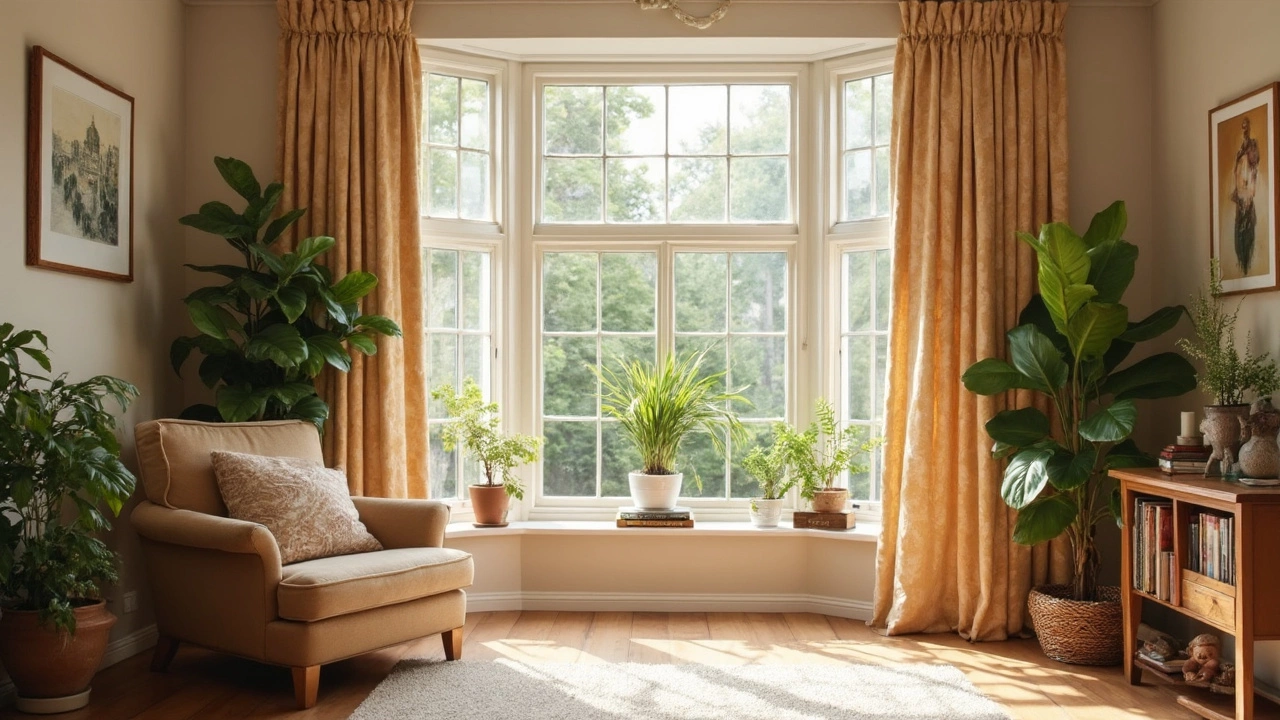If you've ever confused drapes with curtains, you're definitely not alone. Most people swap those words around like they're twins, but they're more like cousins. The differences are actually pretty clear once you know what to look for, and it can totally change the vibe of your room. Think about it: blackout sleep, formal dining rooms, tiny kitchen nooks—all need the right window treatment to work.
Drapes are the heavy hitters. Picture thick, lined fabric that blocks sunlight and adds an upscale, movie-theater feel. Curtains, on the other hand, are lighter, often unlined, and give off a breezy, casual look. The job they do for your windows is different too. Curtains filter light and add softness, while drapes are all about privacy and drama.
- Drapes and Curtains: The Key Differences
- Where and Why to Use Each
- Style and Fabric Choices That Matter
- Tips for Buying and Caring
Drapes and Curtains: The Key Differences
Alright, let’s get real about what sets drapes apart from curtains. Both cover your windows and bring style to a room, but there are some big differences in function, style, and the way they’re used.
Drapes are almost always made from heavy, often lined fabric. This means they block out more sunlight, help with privacy, and even muffle outside noise a little. Most drapes hang floor-to-ceiling and have pleats at the top, giving them a formal, classic look. You’ll see them in bedrooms and living rooms where blocking light is a must.
Curtains, though, are a lot more laid back. They’re usually made from lighter, sometimes see-through fabric—think cotton or linen. Curtains let in more light and don’t always go all the way to the floor. They’re a go-to for kitchens, bathrooms, and spaces where you want to keep things casual and bright.
Here’s a quick side-by-side to make it super clear:
| Feature | Drapes | Curtains |
|---|---|---|
| Weight | Heavy | Light |
| Lining | Usually lined | Rarely lined |
| Length | Floor-length | Varies (usually shorter) |
| Style | Formal | Casual |
| Light Blocking | Excellent | Moderate to Low |
| Common Rooms | Living room, bedroom | Kitchen, bathroom, kids’ rooms |
One quick tip: If you want to keep your room cooler in the summer or warmer in the winter, drapes can help cut down on your energy bills. The Department of Energy says heavy, lined window treatments can reduce heat gain by up to 33% in summer and heat loss by up to 10% in winter. So, aside from just style, your choice actually saves money.
Bottom line: If you crave privacy, blackout sleep, and a polished look, go for drapes. If you’re after sunlight, airiness, and a fun vibe, curtains are the move. Both can work together, too—sometimes one over the other for the best of both worlds.
Where and Why to Use Each
You might wonder if there's an actual reason to pick drapes over curtains or the other way around. The quick answer? Yes. It boils down to where you want to hang them and what kind of function you actually need from your drapes or curtains.
If you want total darkness—think bedrooms, media rooms, or anywhere sunlight ruins your sleep or your Netflix binge—drapes are the winner. They're usually lined (sometimes double-lined), which blocks out light almost completely. Plus, they help keep out street noise and cold drafts.
Curtains shine in spaces where you want natural light without feeling ‘on display’. Living rooms, kitchens, and breakfast nooks are all classic curtain spots. Their lightweight fabric lets light in but still gives you some privacy. Sheer curtains are especially popular in homes with pets—like my curious cat Whiskers—since they’re easy to toss in the wash when fur (or cat nose prints) show up.
- Drapes: Formal settings (dining rooms, home offices), areas needing privacy or blackout, places that could use a little insulation.
- Curtains: Informal spots, letting in light while blocking a direct view, rooms where you want a softer, inviting look.
Here’s a quick side-by-side for when each works best:
| Room | Best Choice | Reason |
|---|---|---|
| Bedroom | Drapes | Blocks light for sleeping, keeps in warmth |
| Living Room | Curtains | Lets in daylight, softens space |
| Home Theater | Drapes | Cuts glare for screens |
| Kitchen | Curtains | Easy to open, lets in sun, easy care |
| Dining Room | Drapes | Formal style, privacy for evening meals |
One more tip: You don’t always have to pick one or the other. Mix them. Layering curtains under drapes gives you the best of both—privacy options, light control, and a more finished look.

Style and Fabric Choices That Matter
There’s a world of difference in the look and feel of drapes versus curtains, and it mainly boils down to fabric and style. If you want to really nail your room’s vibe, this is where you make or break it. The fabric you choose sets the mood and controls things like privacy, light, and even your electric bill.
Drapes usually go for heavier fabrics. Think velvet, brocade, silk, even thick cotton blends. Most drapes are lined, which means they block light way better and help keep heat in or out (hello, lower AC bills). You’ll see drapes in formal dining rooms, classic living rooms, and bedrooms made for blackout sleep. You can even find blackout linings that block up to 99% of sunlight—lifesaver for night shift workers or anyone tired of sunrise alarms.
Curtains are generally lighter. Sheer cotton, linen, polyester, or blends fill this space. Some popular types are gossamer sheers that barely block any light and classic cotton panels for a laid-back look. You mostly see curtains in kitchens, bathrooms, or any space that just needs a touch of softness. They're easy to wash and swap out, which is perfect if you have pets or, in my case, a cat like Whiskers who loves to use curtains for hide-and-seek.
Colors, patterns, and length matter too. Shorter café-style curtains are perfect in a breakfast nook, while drapes that pool on the floor are all about drama. Want a tidy look? Pick drapes or curtains that just kiss the floor. Patterns make a big difference—bold prints lift a plain room, and subtle textures or solids keep things calm.
Here's a quick breakdown of popular window treatment fabrics and their perks:
| Fabric | Typical Use | Pros | Cons |
|---|---|---|---|
| Velvet | Drapes | Great insulation, blocks light, formal vibe | Heavy, harder to clean |
| Linen | Curtains | Lightweight, airy, easy-care | Wrinkles, not totally private |
| Polyester | Curtains | Affordable, easy to wash, fade resistant | Can look cheap in some finishes |
| Brocade | Drapes | Luxurious look, classic style | Expensive, dry clean only |
| Cotton | Drapes & Curtains | Versatile, breathable, easy-care | Might shrink if not pre-washed |
Here’s something to remember when you’re shopping: check the care instructions. Drapes made from velvet or brocade often need dry cleaning, while most cotton and polyester curtains are machine washable. If you're someone who likes to refresh your window treatments with the seasons, go for low-maintenance fabrics you can toss in the washing machine.
Tips for Buying and Caring
If you’re about to hit the store or scroll through a dozen tabs, knowing what works for your home (and what to avoid) saves cash and frustration later. Here’s the rundown on choosing and keeping your new drapes or curtains in great shape.
- Measure before you buy. Get the height from the rod to the floor or sill. Too-short panels never look right, and dragging on the floor can mean constant tripping (and a playground for cats like Whiskers).
- Pretend you’re in the room. If you want blackout for a bedroom, check for lined drapes. For kitchens or bathrooms, go for light, washable curtains—you’ll thank yourself during spring cleaning.
- Check fabric labels. Read those tags. Synthetic blends usually handle machine washing better; velvet or pure linen often need dry cleaning. Cotton is the middle ground—easy to care for but can shrink if not handled right.
- Compare prices beyond aesthetics. Library-chic drapes look amazing, but those thick fabrics are pricier than standard curtains. Don’t be shy about mixing high and low: dress up a window with main drapes and add sheer curtains behind for softness.
- Buy a little extra hardware. Brackets, rings, and rods break more than you think. Having spares on hand means no one-armed curtain situations.
Caring for curtains versus drapes might sound like no big deal, but the wrong move can really shorten their lifespan. Use this quick table to see at a glance what works best during cleaning:
| Material | How to Clean | Tips |
|---|---|---|
| Cotton | Machine washable (cold water) | Air dry to avoid shrinking |
| Polyester | Machine washable | Tumble dry low. Resists wrinkles best. |
| Velvet | Dry clean only | Use a lint roller for surface dust between cleanings |
| Linen | Hand wash or dry clean | Steam to remove wrinkles |
Rotate your window treatments every six months so they don’t fade unevenly in the sun. And if you’re ever not sure about washing, spot test a hidden part first. A little care pays off—you want those window treatments to last longer than your current couch!

